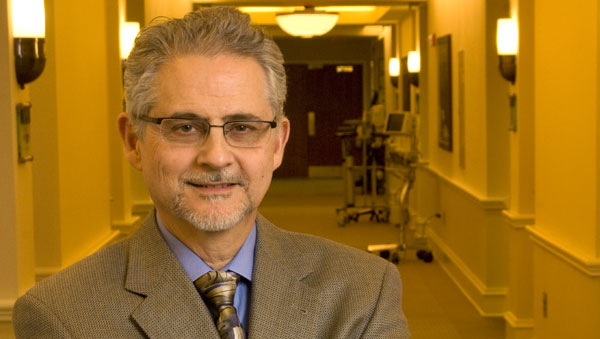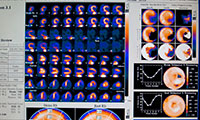Emory Cardiac Toolbox
The Tell-Tale Heart: Ernest Garcia and the Emory Cardiac Toolbox™
A three-dimensional image of a beating heart rotates on the computer monitor in Ernest Garcia's first-floor office at Emory Hospital. On another screen, color-coded virtual "slices" of the heart show the distribution of blood flow while the patient is at rest and while exercising. The area of the cardiac muscle with inadequate blood flow shows up as a black void.
This software program, known as the Emory Cardiac Toolbox™ (ECTb™), is one of the most widely applied cardiac imaging systems in the world, and was developed by Garcia, PhD, a professor of radiology in the School of Medicine. Garcia, who credits his invention with saving his own life, says the most fundamental question the software addresses is whether a patient has coronary artery disease.

Ernest Garcia, PhD
"This is a collection of tools we've developed over thirty years," he says. The latest addition to the toolbox allows physicians to more accurately diagnose and treat heart failure. "In particular, it helps with predicting which patients are going to benefit from specific treatments," Garcia says. "One treatment that is becoming more widespread these days is cardiac resynchronization therapy. Just by using the software and analyzing how the heart beats, we can see how synchronized it is. And if it's not synchronized, we can now predict how well it would improve with resynchronization therapy, a method of restoring the correct mechanical sequence of heart contractions in patients with an irregular heartbeat."
Garcia and his collaborators, including researchers at Cedars-Sinai and Georgia Tech, gained a copyright and Emory began licensing the initially developed tools in 1993 and the first version of ECTb™ in 1998 to companies such as General Electric, Siemens and Philips. In 1999, Atlanta-based Syntermed, Inc. was founded, which sublicenses the software to larger companies as well as selling it directly.
Laura Fritts, Director, License & Patent Strategy in the Office of Technology Transfer at Emory, says, "Licensing ECTb™ to Syntermed reduced the University's liability exposure and relieved Emory of the obligation of meeting FDA requirements as a medical device maker. Additionally, starting Syntermed provided a position from which the technology could expand."
Because the technology was a proven moneymaker, Syntermed hit the ground running and required no outside financing. Emory and Georgia Tech remain shareholders in the privately held firm, which brings in more than $1.5 million a year in revenue—20 percent of which comes back into Garcia’s lab and is used to fund projects and augment researchers’ salaries. Garcia’s research also has been supported by the National Institutes of Health and the Georgia Research Alliance.
Bringing research into the marketplace is "contagious," says Garcia, who serves as Syntermed’s chief scientific advisor. "Some of my colleagues feel that you denigrate research when you commercialize it, that you are no longer a true scientist. I feel exactly the opposite. A lot of funding is being spent on research that never amounts to anything. An invention should be translated to help the health of the public."

Emory Cardiac Toolbox Screen Shot
With over 10,000 licenses sold, ECTb™ is one of the most widely applied methods of cardiac imaging around the world. Garcia believes the toolbox is a best-case partnership between academic researchers and private industry.
"Although our path was sometimes rocky, we were able to develop a product, keeping patients and their needs as the focus and successfully marketing the product and making it profitable," Garcia says. "Once you feel the satisfaction of walking into a little hospital in China or Italy and they are running your software to help a patient, it makes the effort worthwhile."
Read our interview with Ernie on our Emory Technology Transfer Blog
Additional Emory Publications on the Cardiac Toolbox
- Sound Science: A dynamic diagnostic toolbox for cardiac care podcast
- Ernie Garcia featured in School of Medicine Game Changers
- Syntermed Website